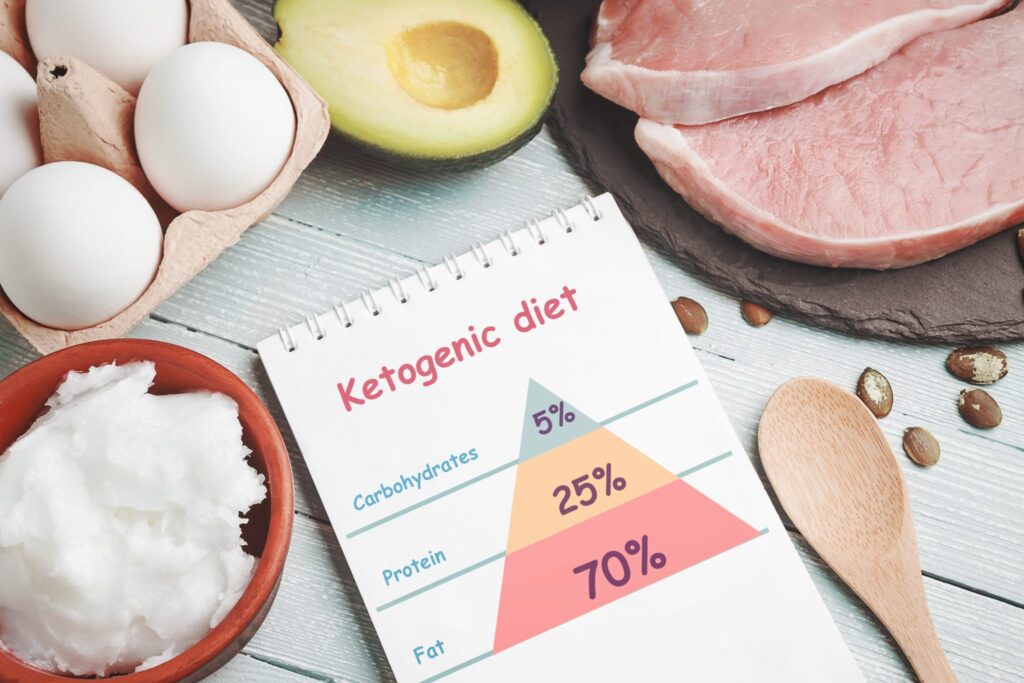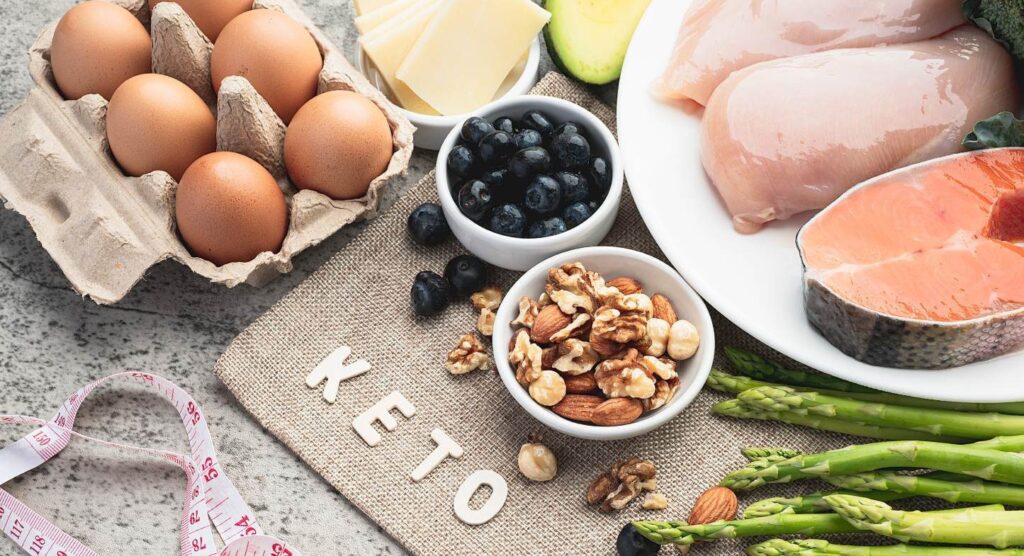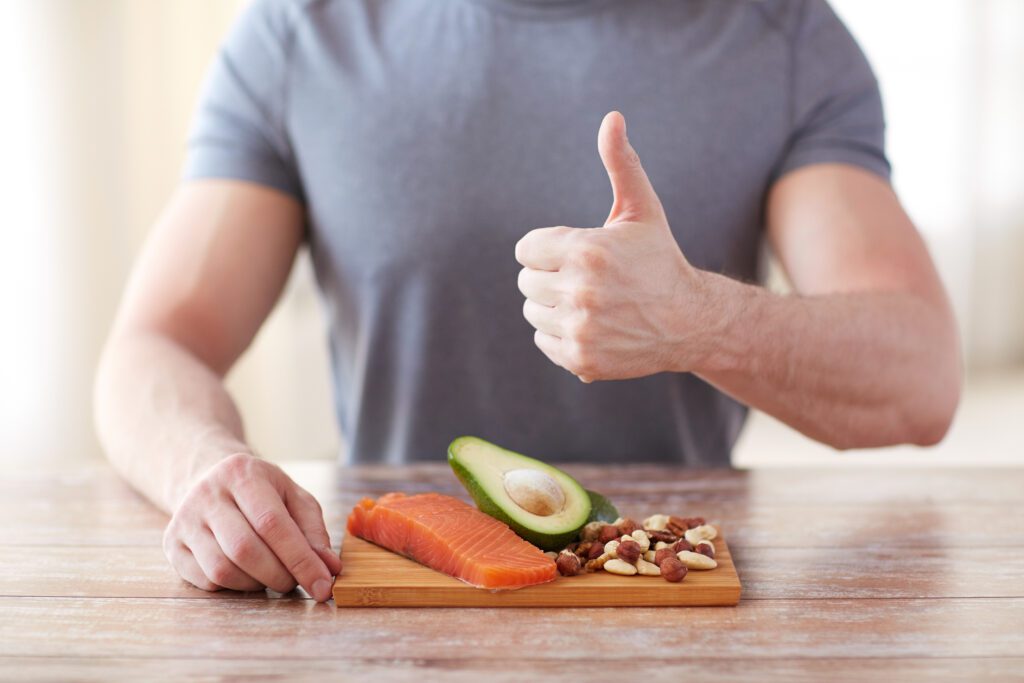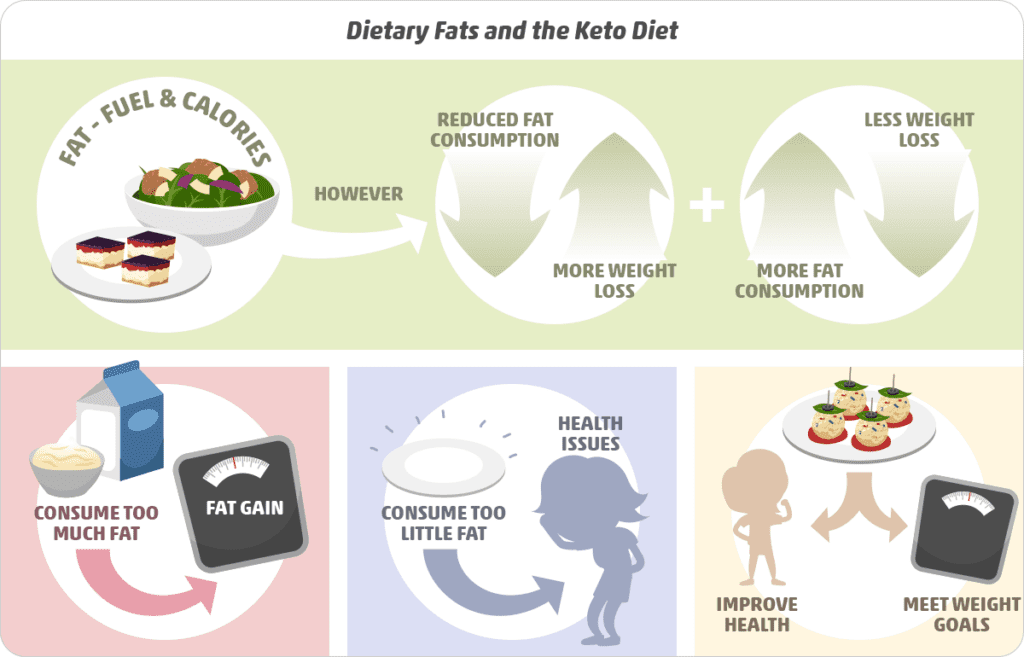Understanding the Keto Diet and Its Benefits

The ketogenic (keto) diet has gained popularity as an effective way to achieve weight loss and improve overall health. The keto diet involves consuming low-carbohydrate, high-fat foods, which forces the body to enter a state of ketosis, where it burns fat for fuel instead of carbohydrates. In this first part, we will introduce the keto diet and explore its benefits, setting the foundation for building a comprehensive keto food list for beginners.
Keto-Friendly Foods to Embrace
When following the keto diet, it’s essential to focus on whole, nutrient-dense foods that are low in carbohydrates and high in healthy fats. Here is a list of keto-friendly foods to embrace:
- Healthy Fats: Avocado, olive oil, coconut oil, grass-fed butter, and ghee are excellent sources of healthy fats to incorporate into the keto diet.
- Low-Carb Vegetables: Leafy greens (spinach, kale, lettuce), cauliflower, broccoli, zucchini, and bell peppers are low in carbohydrates and packed with essential vitamins and minerals.
- Proteins: Choose from sources such as grass-fed beef, pasture-raised poultry, fatty fish (salmon, mackerel), eggs, and tofu.
- Nuts and Seeds: Almonds, walnuts, chia seeds, and flaxseeds are rich in healthy fats and provide a satisfying crunch to meals.
- Dairy: High-fat dairy products like full-fat cheese, Greek yogurt, and heavy cream can be included in moderation.
- Berries: In limited quantities, berries like raspberries, blackberries, and strawberries can be enjoyed for their lower carbohydrate content.
Building a Keto Foods List for Beginners
Creating a keto foods list tailored to beginners is crucial for a smooth transition into the diet. Here is a comprehensive list of keto-approved foods to include in your daily meals:
- Meats and Poultry: Chicken, turkey, beef, pork, lamb, and organ meats (liver, heart) are all keto-friendly protein sources.
- Fish and Seafood: Salmon, tuna, shrimp, crab, and other seafood options are excellent choices for the keto diet.
- Low-Carb Vegetables: As mentioned earlier, prioritize leafy greens, cauliflower, broccoli, and other non-starchy vegetables.
- Eggs: Eggs are a versatile and nutritious staple in the keto diet.
- Healthy Fats and Oils: Avocado, olive oil, coconut oil, butter, and ghee are essential for cooking and flavor.
- Nuts and Seeds: Almonds, walnuts, chia seeds, flaxseeds, and pumpkin seeds make great snacks or additions to meals.
- Dairy Products: Full-fat cheese, Greek yogurt, cottage cheese, and heavy cream are keto-friendly options.
- Berries: In moderation, berries can satisfy your sweet cravings without jeopardizing ketosis.
Best Keto Foods for Success
To ensure success on the keto diet, it’s essential to focus on nutrient-dense, whole foods and avoid processed and high-carb items. Here are some additional best keto foods to consider:
- Avocado: Loaded with healthy fats, fiber, and essential nutrients, avocados are a keto staple.
- Salmon: Fatty fish like salmon provides omega-3 fatty acids and protein.
- Coconut Oil: A fantastic source of medium-chain triglycerides (MCTs), coconut oil is excellent for keto-friendly cooking.
- MCT Oil: MCT oil can be added to drinks and meals to boost fat intake and support ketosis.
- Cauliflower Rice: A low-carb alternative to traditional rice, perfect for keto-friendly recipes.
- Zucchini Noodles: Also known as “zoodles,” they are a delicious substitute for pasta in keto dishes.
By incorporating these keto-friendly foods into your diet and maintaining a proper balance of macros (fat, protein, and carbohydrates), you can embark on a successful keto journey and enjoy the numerous benefits it offers. Remember to consult with a healthcare professional or a registered dietitian before starting any new diet to ensure it aligns with your health needs and goals.
Looking for a convenient PDF version of this keto grocery list designed for beginners? You can easily download and print your own copy to take with you on your next trip to the grocery store. Enjoy the ease of having all the keto-friendly foods at your fingertips as you shop for your healthy and delicious keto meals. Simply click the link below this article to get your printable keto grocery list now!
Crafting Balanced Meals with Keto-Friendly Foods

Now that we have a comprehensive list of keto-friendly foods, it’s essential to understand how to create balanced and satisfying meals while following the keto diet. Building meals that are rich in healthy fats, moderate in protein, and low in carbohydrates is key to achieving and maintaining ketosis. Here’s a guide to crafting balanced meals with keto-friendly foods:
1. Start with Protein: Choose a protein source from the keto-approved list, such as chicken, beef, or fish, as the foundation of your meal. Protein is essential for maintaining muscle mass and keeping you satiated.
2. Add Healthy Fats: Incorporate healthy fats like avocado, olive oil, or nuts to increase the richness and flavor of your dish. Fats are the primary energy source in the keto diet and help keep you feeling full.
3. Include Low-Carb Vegetables: Load your plate with non-starchy vegetables like spinach, broccoli, and cauliflower. These vegetables are low in carbs and high in essential nutrients, vitamins, and fiber.
4. Season with Herbs and Spices: Enhance the taste of your meals with herbs and spices. They add depth and complexity to dishes without contributing significant carbohydrates.
5. Limit High-Carb Ingredients: Avoid or minimize high-carb ingredients such as grains, sugary fruits, and starchy vegetables like potatoes, as they can disrupt ketosis.
6. Plan Snacks Mindfully: Choose keto-friendly snacks like nuts, cheese, or sliced vegetables with dips to keep hunger at bay between meals.
7. Stay Hydrated: Drink plenty of water throughout the day to stay hydrated and support overall health.
8. Monitor Portion Sizes: While the keto diet encourages high-fat foods, portion control is crucial for staying within your daily caloric and macro goals.
Eating Out on the Keto Diet
Following the keto diet doesn’t mean you have to give up dining out or enjoying social gatherings. With a little preparation and mindfulness, you can navigate restaurant menus and social events while staying true to your keto goals.
1. Look for Protein Options: Opt for dishes that feature protein-rich ingredients like grilled chicken, steak, or seafood. Request any high-carb sauces or sides to be served on the side or omitted.
2. Choose Salads with Healthy Fats: Salads can be a great keto-friendly option when you select those with plenty of leafy greens, avocado, nuts, and high-fat dressing like olive oil and vinegar.
3. Customization is Key: Don’t hesitate to ask for substitutions or alterations to fit your dietary preferences. Many restaurants are accommodating to dietary requests.
4. Avoid Bread and Pasta: Steer clear of bread, pasta, and other carb-heavy items typically served as sides in restaurants.
5. Stay Mindful of Hidden Carbs: Be cautious of hidden carbohydrates in sauces, dressings, and marinades. Choose simple, straightforward options whenever possible.
you may be interested in reading this:The Top 10 Diets to Avoid at All Costs
Embracing the Keto Lifestyle

The keto diet is more than just a temporary weight loss plan; it’s a lifestyle that can lead to lasting health benefits when approached mindfully. By incorporating a wide variety of keto-friendly foods and crafting balanced meals, you can enjoy the benefits of the keto diet while supporting your overall well-being.
1. Meal Prep and Planning: Prepare your meals ahead of time and plan your weekly menus to ensure you have keto-friendly options readily available.
2. Listen to Your Body: Pay attention to how your body responds to the keto diet. Everyone is different, and some may need to adjust their macro ratios or food choices to feel their best.
3. Seek Support: Join online keto communities or find a local support group to connect with others on the same journey. Sharing experiences and tips can be motivating and insightful.
4. Be Patient: Transitioning to a new way of eating takes time. Be patient with yourself as you learn and adjust to the keto lifestyle.
Embracing the keto diet with a focus on nutrient-dense foods, mindful eating, and balanced meals can lead to successful weight management and improved overall health. Remember to consult with a healthcare professional or a registered dietitian before starting any new diet to ensure it aligns with your health needs and goals.
Overcoming Challenges and Staying Committed to the Keto Diet
While the keto diet offers numerous benefits, it’s essential to be aware of potential challenges and strategies to stay committed on your keto journey. Here are some tips for overcoming obstacles and maintaining your dedication to the keto lifestyle:
1. The Keto Flu: During the initial phase of starting the keto diet, some individuals may experience flu-like symptoms known as the keto flu. This is a temporary side effect as your body adjusts to using fat as its primary fuel source. To alleviate symptoms, stay well-hydrated, ensure sufficient electrolyte intake, and be patient as your body adapts.
2. Social Pressures: Social gatherings and events may pose challenges when following a specific dietary plan. Prepare for these situations by either bringing your keto-friendly dish or focusing on protein and vegetable-based options available at the event.
3. Traveling on Keto: Traveling while on a keto diet requires planning. Research keto-friendly restaurants and food options at your travel destination, and consider packing convenient keto snacks for the journey.
4. Avoiding Hidden Carbs: Be vigilant about reading food labels and recognizing hidden carbohydrates in packaged foods. Ingredients like sugar, starches, and fillers can add unwanted carbs to your diet.
5. Staying Consistent: Consistency is key to achieving and maintaining ketosis. Avoid frequent cheat days or cheat meals, as they may disrupt the fat-burning state and hinder progress.
6. Adjusting Macros: As you progress on the keto diet, you might find that your macronutrient needs to change. Don’t hesitate to adjust your fat, protein, and carb intake based on your individual health goals and activity level.
7. Seek Professional Guidance: If you encounter difficulties or have specific health concerns, consider consulting with a healthcare professional or a registered dietitian who is knowledgeable about the keto diet. They can offer personalized advice and ensure you are meeting your nutritional needs.
Long-Term Success with Keto Foods

The keto diet can be a sustainable and effective way of eating for the long term. To ensure lasting success with keto foods, consider the following strategies:
1. Diversify Your Meals: Explore new keto-friendly recipes and ingredients to keep your meals interesting and enjoyable.
2. Focus on Whole Foods: Prioritize whole, unprocessed foods to ensure you receive essential nutrients while avoiding hidden sugars and unhealthy fats.
3. Listen to Your Body: Pay attention to your body’s cues and adjust your food choices accordingly. Each person’s nutritional needs may vary, so be attuned to what works best for you.
4. Celebrate Non-Scale Victories: Beyond weight loss, acknowledge and celebrate other benefits of the keto diet, such as improved energy, mental clarity, and better overall well-being.
5. Embrace the Journey: Embrace the journey of discovering new flavors and understanding your body’s responses to different foods. Stay open to learning and evolving as you continue on your keto path.
By approaching the keto diet as a lifestyle and not just a short-term fix, you can reap its long-term benefits for weight management, overall health, and well-being. Remember, the key to success lies in balance, consistency, and a willingness to adapt as you progress on your keto journey.
Keto-Friendly Snacks and Meal Ideas
Adhering to the keto diet doesn’t mean sacrificing delicious and satisfying meals. With a little creativity and planning, you can enjoy a variety of mouthwatering dishes while staying in ketosis. Here are some keto-friendly snack and meal ideas to inspire your culinary journey:
- Avocado Deviled Eggs: Combine the creaminess of avocado with traditional deviled eggs for a tasty and nutritious snack.
- Cheese and Charcuterie Board: Create a spread of assorted cheeses, cured meats, olives, and low-carb vegetables for a delightful and satisfying snack.
- Zucchini Fries: Coat zucchini sticks in almond flour and spices, then bake until crispy for a keto-friendly alternative to traditional fries.
- Guacamole and Veggie Sticks: Enjoy guacamole with celery, cucumber, and bell pepper sticks for a refreshing and nutritious snack.
- Keto Smoothies: Blend unsweetened almond milk, avocado, spinach, and a low-carb protein powder for a filling and creamy keto smoothie.
- Cauliflower Crust Pizza: Top a cauliflower-based pizza crust with marinara sauce, cheese, and your favorite keto-friendly toppings for a delicious pizza without the carbs.
- Keto Tacos: Swap traditional taco shells for lettuce wraps or cheese shells and fill them with seasoned ground beef, avocado, cheese, and salsa.
- Bunless Burgers: Enjoy a juicy burger wrapped in lettuce or topped with a portobello mushroom cap instead of a traditional bun.
- Chicken Alfredo with Zucchini Noodles: Replace pasta with zucchini noodles and top it with a creamy Alfredo sauce for a satisfying and low-carb dinner.
- Keto Stir-Fry: Stir-fry your favorite low-carb vegetables with protein sources like chicken, beef, or tofu in a keto-friendly sauce.
Conclusion
As a beginner on the keto diet, having a comprehensive keto food list and a variety of meal ideas can make the transition smoother and more enjoyable. Remember to focus on whole, nutrient-dense foods, and experiment with different ingredients to discover what works best for your taste preferences and health goals. With dedication and creativity, you can embark on a successful keto journey that promotes weight loss, improved energy, and overall well-being.
Tips for Sustainable Success on the Keto Diet

Maintaining a sustainable and successful keto diet requires dedication and a mindful approach. Here are some valuable tips to help you stay on track and achieve your health and wellness goals:
1. Plan and Prep Ahead: Take time to plan your meals for the week and prepare keto-friendly dishes in advance. Having keto meals readily available will prevent impulsive food choices that may not align with your diet.
2. Read Food Labels: Familiarize yourself with reading food labels to identify hidden sugars and carbohydrates in packaged foods. Look for hidden sources of carbs like maltodextrin, corn syrup, and dextrose.
3. Stay Hydrated: Drink plenty of water throughout the day to support your body’s metabolic processes and promote overall well-being.
4. Incorporate Intermittent Fasting: Consider incorporating intermittent fasting with the keto diet, as it can further enhance fat burning and metabolic flexibility.
5. Monitor Your Progress: Keep track of your meals, macros, and progress using a journal or a mobile app. Monitoring your journey can help you identify patterns and make necessary adjustments.
6. Seek Support and Accountability: Surround yourself with a supportive community of friends, family, or online groups that share your keto journey. Having a support system can provide encouragement and accountability.
7. Be Mindful of Carb Creep: Over time, it’s easy to let carb intake gradually increase. Stay mindful of your carb intake to avoid unintentionally drifting away from ketosis.
8. Focus on Whole Foods: Prioritize whole, nutrient-dense foods over processed keto alternatives. Emphasize quality sources of fats, proteins, and vegetables.
9. Include Physical Activity: Incorporate regular physical activity into your routine to support your overall health and weight management.
10. Listen to Your Body: Pay attention to how your body responds to the keto diet. If something doesn’t feel right, consider adjusting your food choices or macros accordingly.
11. Avoid Comparisons: Remember that everyone’s body and journey are unique. Avoid comparing your progress to others and focus on your individual health and well-being.
12. Be Patient and Persistent: The keto diet is a lifestyle change, and results may take time. Be patient, stay persistent, and celebrate your progress along the way.
Final Thoughts
The keto diet offers a promising approach to weight management and improved health. By embracing a diet rich in healthy fats, moderate in protein, and low in carbohydrates, you can tap into the body’s natural ability to burn fat for fuel. Remember that the keto diet is not a one-size-fits-all approach, and it’s essential to listen to your body’s signals and adjust your approach accordingly.
Before starting any new diet or lifestyle change, it’s advisable to consult with a healthcare professional or a registered dietitian, especially if you have any pre-existing health conditions or concerns. With dedication, mindful choices, and a balanced approach, you can experience the benefits of the keto diet and enjoy a healthier and more energetic life.
Download Our Keto Grocery List PDF
Would you like a downloadable PDF version of this keto grocery list for beginners? You can print it out and take it with you on your next trip to the grocery store! Feel free to download your copy now.

Amelya Evelyn is freelance writer, health reporter, and author, she shares her experiences in the hope that others will feel less alone in their health struggles.She loves breaking down complex science and health information, making it easier for people to understand




